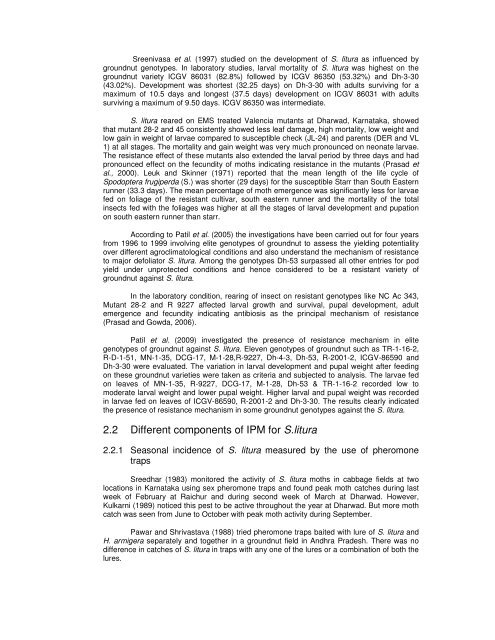screening elite genotypes and ipm of defoliators in groundnut
screening elite genotypes and ipm of defoliators in groundnut
screening elite genotypes and ipm of defoliators in groundnut
You also want an ePaper? Increase the reach of your titles
YUMPU automatically turns print PDFs into web optimized ePapers that Google loves.
Sreenivasa et al. (1997) studied on the development <strong>of</strong> S. litura as <strong>in</strong>fluenced by<br />
<strong>groundnut</strong> <strong>genotypes</strong>. In laboratory studies, larval mortality <strong>of</strong> S. litura was highest on the<br />
<strong>groundnut</strong> variety ICGV 86031 (82.8%) followed by ICGV 86350 (53.32%) <strong>and</strong> Dh-3-30<br />
(43.02%). Development was shortest (32.25 days) on Dh-3-30 with adults surviv<strong>in</strong>g for a<br />
maximum <strong>of</strong> 10.5 days <strong>and</strong> longest (37.5 days) development on ICGV 86031 with adults<br />
surviv<strong>in</strong>g a maximum <strong>of</strong> 9.50 days. ICGV 86350 was <strong>in</strong>termediate.<br />
S. litura reared on EMS treated Valencia mutants at Dharwad, Karnataka, showed<br />
that mutant 28-2 <strong>and</strong> 45 consistently showed less leaf damage, high mortality, low weight <strong>and</strong><br />
low ga<strong>in</strong> <strong>in</strong> weight <strong>of</strong> larvae compared to susceptible check (JL-24) <strong>and</strong> parents (DER <strong>and</strong> VL<br />
1) at all stages. The mortality <strong>and</strong> ga<strong>in</strong> weight was very much pronounced on neonate larvae.<br />
The resistance effect <strong>of</strong> these mutants also extended the larval period by three days <strong>and</strong> had<br />
pronounced effect on the fecundity <strong>of</strong> moths <strong>in</strong>dicat<strong>in</strong>g resistance <strong>in</strong> the mutants (Prasad et<br />
al., 2000). Leuk <strong>and</strong> Sk<strong>in</strong>ner (1971) reported that the mean length <strong>of</strong> the life cycle <strong>of</strong><br />
Spodoptera frugiperda (S.) was shorter (29 days) for the susceptible Starr than South Eastern<br />
runner (33.3 days). The mean percentage <strong>of</strong> moth emergence was significantly less for larvae<br />
fed on foliage <strong>of</strong> the resistant cultivar, south eastern runner <strong>and</strong> the mortality <strong>of</strong> the total<br />
<strong>in</strong>sects fed with the foliages was higher at all the stages <strong>of</strong> larval development <strong>and</strong> pupation<br />
on south eastern runner than starr.<br />
Accord<strong>in</strong>g to Patil et al. (2005) the <strong>in</strong>vestigations have been carried out for four years<br />
from 1996 to 1999 <strong>in</strong>volv<strong>in</strong>g <strong>elite</strong> <strong>genotypes</strong> <strong>of</strong> <strong>groundnut</strong> to assess the yield<strong>in</strong>g potentiality<br />
over different agroclimatological conditions <strong>and</strong> also underst<strong>and</strong> the mechanism <strong>of</strong> resistance<br />
to major defoliator S. litura. Among the <strong>genotypes</strong> Dh-53 surpassed all other entries for pod<br />
yield under unprotected conditions <strong>and</strong> hence considered to be a resistant variety <strong>of</strong><br />
<strong>groundnut</strong> aga<strong>in</strong>st S. litura.<br />
In the laboratory condition, rear<strong>in</strong>g <strong>of</strong> <strong>in</strong>sect on resistant <strong>genotypes</strong> like NC Ac 343,<br />
Mutant 28-2 <strong>and</strong> R 9227 affected larval growth <strong>and</strong> survival, pupal development, adult<br />
emergence <strong>and</strong> fecundity <strong>in</strong>dicat<strong>in</strong>g antibiosis as the pr<strong>in</strong>cipal mechanism <strong>of</strong> resistance<br />
(Prasad <strong>and</strong> Gowda, 2006).<br />
Patil et al. (2009) <strong>in</strong>vestigated the presence <strong>of</strong> resistance mechanism <strong>in</strong> <strong>elite</strong><br />
<strong>genotypes</strong> <strong>of</strong> <strong>groundnut</strong> aga<strong>in</strong>st S. litura. Eleven <strong>genotypes</strong> <strong>of</strong> <strong>groundnut</strong> such as TR-1-16-2,<br />
R-D-1-51, MN-1-35, DCG-17, M-1-28,R-9227, Dh-4-3, Dh-53, R-2001-2, ICGV-86590 <strong>and</strong><br />
Dh-3-30 were evaluated. The variation <strong>in</strong> larval development <strong>and</strong> pupal weight after feed<strong>in</strong>g<br />
on these <strong>groundnut</strong> varieties were taken as criteria <strong>and</strong> subjected to analysis. The larvae fed<br />
on leaves <strong>of</strong> MN-1-35, R-9227, DCG-17, M-1-28, Dh-53 & TR-1-16-2 recorded low to<br />
moderate larval weight <strong>and</strong> lower pupal weight. Higher larval <strong>and</strong> pupal weight was recorded<br />
<strong>in</strong> larvae fed on leaves <strong>of</strong> ICGV-86590, R-2001-2 <strong>and</strong> Dh-3-30. The results clearly <strong>in</strong>dicated<br />
the presence <strong>of</strong> resistance mechanism <strong>in</strong> some <strong>groundnut</strong> <strong>genotypes</strong> aga<strong>in</strong>st the S. litura.<br />
2.2 Different components <strong>of</strong> IPM for S.litura<br />
2.2.1 Seasonal <strong>in</strong>cidence <strong>of</strong> S. litura measured by the use <strong>of</strong> pheromone<br />
traps<br />
Sreedhar (1983) monitored the activity <strong>of</strong> S. litura moths <strong>in</strong> cabbage fields at two<br />
locations <strong>in</strong> Karnataka us<strong>in</strong>g sex pheromone traps <strong>and</strong> found peak moth catches dur<strong>in</strong>g last<br />
week <strong>of</strong> February at Raichur <strong>and</strong> dur<strong>in</strong>g second week <strong>of</strong> March at Dharwad. However,<br />
Kulkarni (1989) noticed this pest to be active throughout the year at Dharwad. But more moth<br />
catch was seen from June to October with peak moth activity dur<strong>in</strong>g September.<br />
Pawar <strong>and</strong> Shrivastava (1988) tried pheromone traps baited with lure <strong>of</strong> S. litura <strong>and</strong><br />
H. armigera separately <strong>and</strong> together <strong>in</strong> a <strong>groundnut</strong> field <strong>in</strong> Andhra Pradesh. There was no<br />
difference <strong>in</strong> catches <strong>of</strong> S. litura <strong>in</strong> traps with any one <strong>of</strong> the lures or a comb<strong>in</strong>ation <strong>of</strong> both the<br />
lures.
















